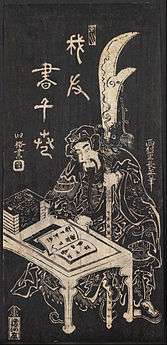Nishimura Shigenaga
Nishimura Shigenaga (Japanese: 西村 重長; c. 1697 – 23 July 1756) was a Japanese ukiyo-e artist.
Shigenaga was born c. 1697 in Edo (modern Tokyo).[1] He worked as a landlord in Tōriabura-chō[2] before moving to the Kanda district, where he ran a bookshop and taught himself art;[1] he is not known to have had a teacher.[3] His work began to appear c. 1719. He worked in a variety of genres and formats.[1] His earlier work tended to be yakusha-e portraits of kabuki actors in the style of the Torii school; his later work is in an idiom more his own, incorporating the influence of Okumura Masanobu and Nishikawa Sukenobu.[2] Other genres he worked in include landscapes, kachō-e pictures of scenes of nature, and historical scenes.[3] He made a number of uki-e "floating pictures" incorporating geometric perspective. The number of uki-e he produced was second only to Masanobu, who asserted himself the originator of the technique.[4]
Shigenaga's better-known work includes the series Fifty-four Sheets of Genji, a collaborative series with Torii Kiyomasu II in c. 1730–35; and the Picture Book of Edo Souvenirs in 1753.[1] He produced some of the earliest ukiyo-e landscape prints; in 1727, his was the first set of prints of Lake Biwa.[5] His work had a strong influence on later artists such as Suzuki Harunobu and Ishikawa Toyonobu,[1] who may have been students of Shigenaga's;[6] Toyonobu may have been Nishimura Shigenobu, Shigenaga's most prominent student.[2]
- Prints by Shigenaga



.jpg)
References
- 1 2 3 4 5 Marks 2012, p. 38.
- 1 2 3 Michener 1954, p. 396.
- 1 2 Japan Ukiyo-e Association 1982, p. 70.
- ↑ Japan Ukiyo-e Association 1982, p. 72.
- ↑ King 2010, p. 45.
- ↑ Marks 2012, p. 38; Michener 1954, p. 396.
Works cited
- Japan Ukiyo-e Association (1982). Genshoku Ukiyo-e Dai-Hyakka Jiten 原色 浮世絵大百科事典 第6巻 [Original Colour Grand Ukiyo-e Encyclopaedia]. 6. Taishūkan Publishing.
- King, James (2010). Beyond the Great Wave: The Japanese Landscape Print, 1727–1960. Peter Lang. ISBN 978-3-0343-0317-0.
- Marks, Andreas (2012). Japanese Woodblock Prints: Artists, Publishers and Masterworks: 1680–1900. Tuttle Publishing. ISBN 978-1-4629-0599-7.
- Michener, James Albert (1954). The Floating World. University of Hawaii Press. ISBN 978-0-8248-0873-0.
External links
 Media related to Nishimura Shigenaga at Wikimedia Commons
Media related to Nishimura Shigenaga at Wikimedia Commons